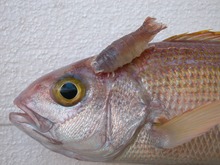Cymothoidae
| Cymothoidae | ||||||||||
|---|---|---|---|---|---|---|---|---|---|---|

|
||||||||||
| Systematics | ||||||||||
|
||||||||||
| Scientific name | ||||||||||
| Cymothoidae | ||||||||||
| Leach , 1815 |
Cymothoidae are a family of woodlice that live parasitically on fish.
features
With a length of up to 75 millimeters, some of the largest woodlice belong to the Cymothoidae. The animals show a number of adaptations to the parasitic way of life. With the exception of Artystone trysibiu , they have seven peraeopods , which are designed to be gripping tools in that the first six, but mostly all seven, have hook-like end links. The surface of the peraeopods is often enlarged, possibly to aid the breathing of the relatively large animals. The eyes are well developed in larvae, but usually reduced in adults. The antennas are evenly pointed without a broadened base. The mouthparts are mostly heavily modified. The maxillipedas are reduced to short, three-part buttons. The first maxillae are single-limbed and narrow, and lie close together to carry blood from the host to the mouth. The second maxillae are short and bilobed. All of the named limbs usually have thorns with which they can be anchored to the host. The mandibles have a well-developed cutting edge to cut through the host's skin. The pleon usually consists of six segments, except in Ourozeuktes , where all segments are fused with the telson and Asotana splendida with four segments and pleotelson.
Way of life
Cymothoidae occur as ectoparasites on fish in the shallow areas of tropical and subtropical seas, in brackish water and sometimes also in fresh water. Most species have a relatively high host specificity and settle on the surface of the skin, in the gill area or in the oral cavity; a number of South American freshwater species also burrow into the tissue of their host. Cymothoidae are proterandric , so they begin their lives as males and colonize their hosts in this phase. They feed on blood, tissue, and possibly some of the host's food. After several moults, the animals transform into females, the decisive signal possibly being the arrival of a second male at the same host. In this case, the conversion is then suppressed by neuroendocrine signals from the female. As a result, pairs can usually be found on the host animals. While the males probably always live parasitically, the females of most species do not eat at least during the reproductive phases. In Cymothoa exigua and Ceratothou oestroides , the females cause atrophy of the host's tongue . The females keep fertilized eggs in brood pouches under the body until they hatch. The number of eggs depends on the size of the animals and is between 200 and 1600, but mostly between 300 and 600. The larvae are free-swimming after hatching.
While Cymothoidae usually have little influence on the host under normal conditions, young fish can be killed by the infestation, while in older fish the growth can be reduced and the sensitivity to stress factors is increased. Secondary infections with microorganisms do occur but are not particularly common.
Genera
So far around 40 different genera have been discovered and described:
- Aegathoa Dana, 1853
- Agarna Schioedte & Meinert, 1884
- Amblycephalon Pillai, 1954
- Anilocra Leach, 1818
- Artystone Schioedte, 1866
- Asotana Schioedte & Meinert, 1881
- Braga Schioedte & Meinert, 1881
- Catoessa Schioedte & Meinert, 1884
- Ceratothoa Dana, 1852
- Cinusa Schioedte & Meinert, 1884
- Creniola Bruce, 1987
- Cterissa Schioedte & Meinert, 1884
- Cymothoa Fabricius, 1787
- Elthusa Schioedte & Meinert, 1884
- Emetha Schioedte & Meinert, 1883
- Glossobius Schioedte & Meinert, 1883
- Ichthyoxenus Herklots, 1870
- Idusa Schioedte & Meinert, 1884
- Isonebula Taberner, 1977
- Joryma Bowman & Tareen, 1983
- Kuna Williams & Williams, 1986
- Lathraena Schioedte & Meinert, 1881
- Livoneca Leach, 1818
- Lobothorax Bleeker, 1857
- Mothocya Costa in Hope, 1851
- Nerocila Leach, 1818
- Norileca Bruce, 1990
- Olencira Leach, 1818
- Ourozeuktes H. Milne-Edwards, 1840
- Paracymothoa Lemos de Castro, 1955
- Philostomella Szidat & Schubart, 1960
- Pleopodias Richardson, 1910
- Plotor Schioedte & Meinert, 1881
- Pseudoirona Pillai, 1964
- Renocila Miers, 1880
- Rhiothra Schioedte & Meinert, 1884
- Riggia Szidat, 1948
- Ryukyua Williams & Bunkley-Williams, 1994
- Smenispa Özdikmen, 2009
- Telotha Schioedte & Meinert, 1884
- Tetragonocephalon Avdeev, 1978
Web links
Individual evidence
- ^ A b Richard C. Brusca: A monograph on the Isopoda Cymothoidae (Crustacea) of the eastern Pacific . In: Zoological Journal of the Linnean Society . tape 73 , 1981, pp. 117–199 (English, full text [PDF; 5.4 MB ]).
- ↑ Glenn L. Hoffman: Parasites of North American freshwater fishes . 2nd Edition. Cornell University Press, 1999, ISBN 0-8014-3409-2 , pp. 326 .
- ↑ Family entry at ITIS
- ↑ Hüseyin Özdikmen: A new name, Smenispa for the preoccupied isopod genus Enispa Schioedte & Meinert, 1884 (Isopoda: cymothoidae) . In: Mun. Ent. Zool. Vol. 4, No. 2 , 2009, p. 611–612 (English, munisentzool.org [PDF]).


